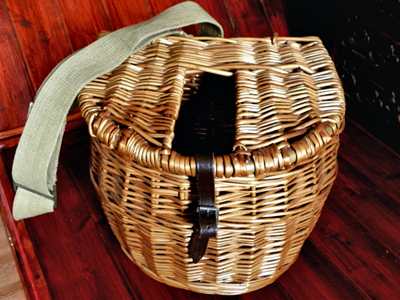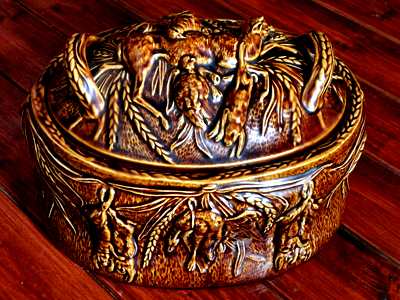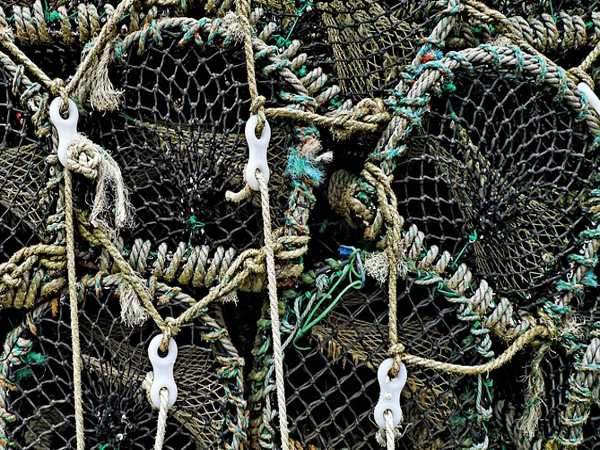The world of hunting and traditional culinary practices is steeped in history, filled with unique tools, techniques, and recipes that have been passed down through generations. Among these, the humble creel—a small wicker basket used by fishermen—stands out as a symbol of the age-old connection between humans and nature.
In this article, we will dive into the fascinating world of creels, game bags, and the eccentricities of old-world cooking, shedding light on a time when practicality and tradition went hand in hand.
The Creel: A Fisherman’s Timeless Companion
A creel, often seen slung over the shoulder of a fisherman, is more than just a basket. This small, woven container is designed to keep fish fresh during a day’s catch, lined with moss moistened by river water.

The origin of the word “creel” is as intricate as the basket itself, possibly deriving from the old French “criellen” (meaning latticework) or the Latin “crātis” (a wickerwork hurdle). The first recorded use of the word dates back to around 1425, as mentioned in Andrew of Wyntoun’s The Orygynale Cronykil of Scotland.
Despite its deep roots in fishing culture, the creel is surprisingly absent from some of the most well-known literary works on angling, such as Isaak Walton’s The Compleat Angler (1653). Yet, its practical design has endured for centuries, making it a cherished tool among those who value tradition and the simple pleasures of a day spent by the water.
The Game Bag: A Hunter’s Essential Gear
While the creel is the fisherman’s faithful companion, the game bag serves a similar purpose for hunters. Designed to carry the day’s bounty, whether feathered or furred, the game bag is a versatile piece of equipment. It typically features a removable, waterproof lining and a netted outer layer, allowing for rapid cooling of the game. Some hunters, in a nod to practicality, have even used these bags as makeshift briefcases, slinging them over their shoulders on their way to work.

The game bag’s design reflects a time when hunting was not just a sport but a way of life. It symbolizes the careful balance between respect for nature and the necessity of survival, a balance that has shaped human history for millennia.
Cooking Game: From Pie Dishes to Peculiar Recipes
After the hunt, the next challenge was turning the day’s catch into a hearty meal. In the 1960s, Portmeirion Pottery brought a touch of Victorian charm to modern kitchens with their game pie dishes. These dishes, adorned with reliefs of ears of wheat, were available in three colors—white, brown, and blue. However, their popularity waned, possibly due to their tendency to discolor in hot ovens.

But perhaps no recipe captures the quirky spirit of old-world cooking quite like Willie Fowler’s recipe for cormorant, as detailed in his 1965 book Countryman’s Cooking. Fowler, a former RAF bomber pilot turned farmer, had a penchant for unusual dishes, and his cormorant recipe is a testament to that. The process involved soaking the bird in petrol, burning off its feathers, and then burying it in sandy soil for two weeks to improve its flavor. The final step? Roasting it in a hot oven with a paste of methylated spirit and curry powder—a concoction so bizarre that even Fowler himself recommended throwing it away!
The Legacy of Traditional Tools and Recipes
The tools and recipes from the past offer a window into a world where life was lived at a slower pace, and every item had a purpose. The creel and the game bag, with their simple yet effective designs, are reminders of a time when people were more in tune with the natural world around them. Likewise, the peculiar recipes like Fowler’s cormorant reflect a resourcefulness and creativity that is often lost in today’s fast-paced society.
As we look back on these traditions, we are reminded of the importance of preserving the knowledge and practices of our ancestors. Whether it’s the craftsmanship of a well-woven creel or the art of preparing game, these skills are part of our shared heritage and deserve to be celebrated.
Conclusion:
In an age where modern conveniences often overshadow traditional practices, it’s worth taking a moment to appreciate the ingenuity and practicality of the past. From the simple elegance of a creel to the rugged utility of a game bag, these items are more than just tools—they are symbols of a way of life that valued self-sufficiency and a deep connection to the natural world. And while some recipes, like Fowler’s infamous cormorant dish, may seem outlandish today, they serve as a humorous reminder of the lengths to which people once went in the pursuit of culinary adventure.

